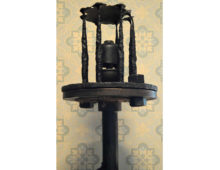Tagged with Paintings
Resource : Portrait of Mary Wollstonecraft
Mary Wollstonecraft was a revolutionary writer who made a powerful case for educating and emancipating women. She is still regarded as one of the founders of modern British feminism.
Resource : Portrait of James Barry
Born Margaret Bulkley, James Barry lived most of his life as a man, qualifying as a doctor and becoming an accomplished and respected military surgeon. His identity as a woman was only revealed when his maid laid him out after his death. It is not known whether Barry identified as a man or whether he simply kept up a disguise in order to have a medical career, at a time when women were denied this opportunity.
Resource : The Fighting Temeraire
JMW Turner is one of Britain’s best loved artists. He became known as the ‘painter of light’ due to his trademark style and use of colour in landscapes and seascapes. The Fighting Temeraire, one of his most famous oil paintings, shows the warship Temeraire being towed by a steam-powered tug on its last ever journey before being broken up. It is said to symbolise the decline of Britain’s naval power, the passing of the ‘glorious’ age of sail and the growth of ‘modern’ technology in an increasingly industrialised Britain. The industrial revolution and the history of the Royal Navy were therefore both saluted, through Turner’s revolutionary brand of romantic landscape painting.
Resource : Ira Aldridge as Othello, the Moor of Venice
Ira Aldridge (1807 – 1867) was the first Black actor to play leading Shakespearian roles on the stage, both in Britain and across Europe.
Resource : South Wales industrial landscape
The industrial revolution describes the dramatic and long-lasting change in Wales’s landscape and infrastructure during the eighteenth and nineteenth centuries. As innovations in steam power and the design of machinery developed and advanced, new factories, mines, railways and canals began to radically transform the landscape, manufacturing, and the way people lived and worked.
Resource : The Cult of the Supreme Being
The French revolution was a period of major uprising and upheaval for France, between 1789 and 1799, when people fought for an end to the power and privilege held by the monarchy, aristocracy and Catholic Church, over ordinary people. Maximilien Robespierre (1758 – 1794) was a powerful and ruthless figure in the revolution. He introduced the Cult of the Supreme Being as a new state religion, as part of his vision for revolutionary France.
Resource : Hannah More (1745 – 1833)
Hannah More (1745-1833) was a poet, playwright, anti-slavery campaigner and one of the most influential female philanthropists of the Age of Revolution. Seen by some as an early feminist, and others as an anti-feminist, she remains a controversial figure today.
Resource : The death of Major Peirson, 6 January 1781
In 1781, France invaded the Channel Island of Jersey. It was successfully defended by the British – an important victory at a time when they were failing in their war with America (American War of Independence) and about to lose control of their American colonies. This painting celebrates the victory and commemorates the death of Major Francis Peirson and his refusal to surrender.
Resource : Battlefield Injuries Illustrated by Charles Bell
This entry includes graphic illustrations of war injuries which some may find upsetting.
This is a watercolour painting by Charles Bell, a British Army surgeon who helped to treat the wounded after the Battle of Waterloo. His haunting paintings are stark reminders of what early 19th century battle injuries were like. They are rare images executed by a practising surgeon and artist, which was an unusual combination. While his portraits powerfully show the agony and trauma experienced by these young men, they also describe their wounds with anatomical accuracy.
Resource : William Godwin
The writer, William Godwin is perhaps not the most famous but was one of the most influential British radicals and political philosophers of the Age of Revolution. He was married to the revolutionary feminist writer Mary Wollstonecraft, and was the father of Frankenstein author Mary Shelley. He established the Juvenile Library and had a powerful influence on the Romantic poets, including William Wordsworth and his son-in-law Percy Shelley.


